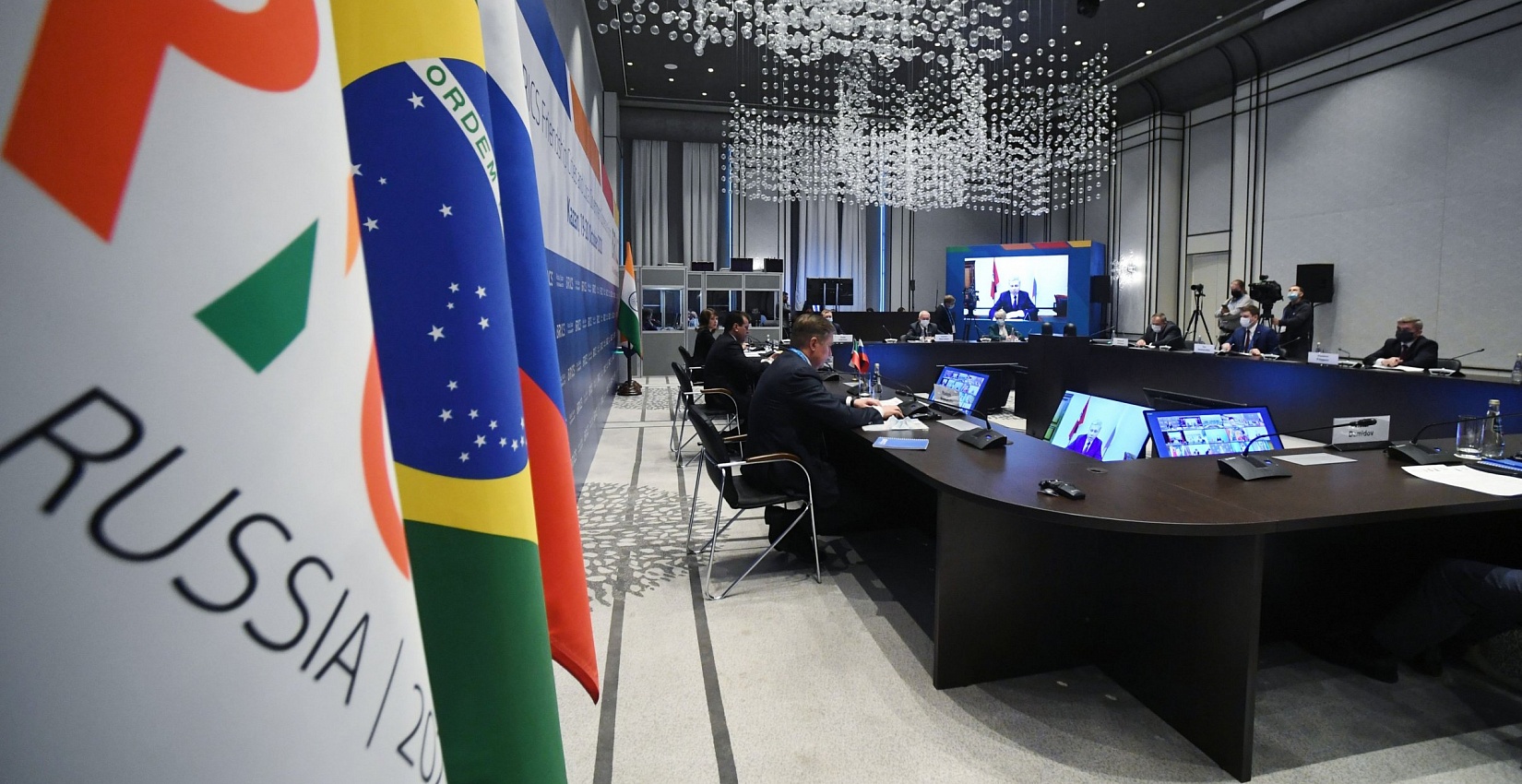In the last few years, nearly a decade into its establishment and operation, BRICS is facing a crisis. On the one hand, the crisis has a specific set of causes, which include an economic downturn in three of its countries (Russia, Brazil, South Africa) as well as the worsening contradictions between China and India or between China and Brazil. The accumulated dissatisfaction with the actual results of the grouping’s ten years of operation has also contributed to these trends, since many initiatives remained mere slogans, including the goal to amplify the voice of developing countries and to seek reforms when it comes to institutions of global governance.
If we slightly abstract from the currently acute phase of the crisis, we can outline several scenarios, envisioning how BRICS could move forward. These not appear to be exhaustive and may complement each other:
The first scenario is a rebirth of the association through achieving extensive growth and inviting new countries, which would turn BRICS into another G20, although for developing countries only. Such an initiative has been expressed since the early years of BRIC and, later, BRICS. Obviously, the Russian leadership’s previous assurances of absolute constructiveness toward all external forces should be reconsidered if the agenda of circumventing sanctions and creating financial, logistical, and other mechanisms alternative to those of the West is actively promoted.
The second scenario is the increasingly dominant role of China, the growing dependence of other countries on it, especially of Russia, and the transformation of BRICS into a mutual aid fund, where China will support its partner countries through the New Development Bank and other instruments, while pushing its own agenda and interests. This scenario is already, if partially, the case. But the obvious obstacle to this scenario will be the position of India, which is not interested in strengthening the role of its strategic competitor.
The third scenario is a careful search for a balance while preserving the existing membership of the association, goals and objectives. For this to happen, China, India and Brazil need to revise their approaches to bilateral relations, smoothing out their contradictions.
The dialectics of any association’s progressive evolution entails periods of growth, agenda expansion, predominance of centripetal forces, crisis passing, when it is essential to review goals and objectives and synchronize views. In the last few years, nearly a decade into its establishment and operation, BRICS is facing a crisis. On the one hand, the crisis has a specific set of causes, which include an economic downturn in three of its countries (Russia, Brazil, South Africa) as well as the worsening contradictions between China and India or between China and Brazil. The accumulated dissatisfaction with the actual results of the grouping’s ten years of operation has also contributed to these trends, since many initiatives remained mere slogans, including the goal to amplify the voice of developing countries and to seek reforms when it comes to institutions of global governance.
Perhaps, most salient and illustrative was the evolution in Brazil’s approach to BRICS. Former presidents Lula da Silva and Dilma Rousseff had a hand in establishing the association, both sharing a clear understanding of how it should operate to achieve the country’s main strategic foreign policy objective, which is to assume the position of leadership across the Global South. One can recall the words of Celso Amorim, Brazil’s former Foreign Minister (2003 to 2010), at the dawn of BRICS in 2008: “The BRIC countries could serve as a bridge between industrialized and developing countries for sustainable development and a more balanced international economic policy. We should promote a more democratic world order by ensuring the fullest participation of developing countries in decision-making bodies.” From these words, it is evident that the BRICS countries have repeatedly reiterated the point that the association is not an alliance against someone, it will not supplant cooperation with developed countries—rather, it aims to allow the BRICS nations to conduct such cooperation in a more equal manner. Brazil’s activism within BRICS was complemented by biregional and bilateral formats with the developing world (the Africa-South America Summit or the Forum of East Asia-Latin America Cooperation), where the country could take the lead.
Brazil confronted serious political and economic crises in the mid-2010s, which could not but affect the dynamics of BRICS as a whole, a trend coupled with economic slowdowns in Russia and South Africa. Many economists have noted that the key challenge for the Brazilian economy at the time was the low productivity, which could be solved by a serious modernization, including through attracting FDI in technology. The new elites, upon coming to power in 2018 (the Bolsonaro government), saw the solution not so much in intensifying South-South technological and investment cooperation as in building alliances with developed countries (North-South). This does not mean that the new leadership did not recognize the importance of the mechanisms and instruments functioning within BRICS (the New Development Bank or platforms for technological cooperation, including BRICS STI Framework). Rather, the scale of their impact did not correspond to what was required for the real technological breakthrough of the “tropical giant.”
In the year of its presidency in 2019, Brazil demonstrated the approach that the association really needed to move forward with its development. After an over-extensive sprawl of the agenda in the previous years, when BRICS included initiatives and projects from almost all spheres, it was necessary to focus on really important, compromise priorities, achieving their in-depth elaboration. This is reflected in the much narrower priorities that Brazil chose to state. However, the quality of their elaboration was at the highest level, which was duly noted by Sergei Ryabkov, Russia’s Sherpa in BRICS.
However, a period of concentration should be followed by new expansion and growth. Alas, BRICS has so far failed to demonstrate real potential for this, given the association’s setbacks in fighting COVID-19. The events in Ukraine of early 2022, however, have undoubtedly become the most serious shock and test for the association. Adapting BRICS to the new realities depends on whether the current crisis is a game changer or a challenge to the system rather than a threat to the previous vector of its development. The reactions in the first or second scenario should be different, although it is obviously difficult to predict them, given that the outlines of the new reality have not yet finally emerged. Not a single BRICS country has supported Western sanctions against Russia—still, this does not mean that they are ready to boldly enhance cooperation with our country, turning a blind eye to understandable threats of secondary sanctions, coming from the U.S. and the EU.
Nevertheless, if we slightly abstract from the currently acute phase of the crisis, we can outline several scenarios, envisioning how BRICS could move forward. These not appear to be exhaustive and may complement each other:
The first scenario is a rebirth of the association through achieving extensive growth and inviting new countries, which would turn BRICS into another G20, although for developing countries only. Such an initiative has been expressed since the early years of BRIC and, later, BRICS. First of all, options of involving a major Islamic country to transform the association into a conditional alliance of civilizations were discussed. Egypt is showing interest in joining BRICS, while it was not the first time in 2021 that Argentina was mentioned as a potential member of the grouping. Today, there is a lot of talk about the BRICS+ format, and the idea of “integration of integration” is returning. The latter option seems unlikely because of the growing centrifugal trends in Latin America and in the Caribbean (CELAC, Mercosur) and the EAEC. But the issue of strategic goals for BRICS to pursue, its values and ideals to preserve, and whether it could effectively contribute to the development of the participating countries will arise with renewed vigor once new countries are included. The question of positioning the association as an alternative to the West or as a bridge for more effective interaction with developed countries will be very difficult for Russia in light of its confrontation with Western nations. Obviously, the Russian leadership’s previous assurances of absolute constructiveness toward all external forces should be reconsidered if the agenda of circumventing sanctions and creating financial, logistical, and other mechanisms alternative to those of the West is actively promoted.
The second scenario is the increasingly dominant role of China, the growing dependence of other countries on it, especially of Russia, and the transformation of BRICS into a mutual aid fund, where China will support its partner countries through the New Development Bank and other instruments, while pushing its own agenda and interests. This scenario is already, if partially, the case. It is no secret that access to additional resources of the NDB attracts countries indicating their desire to join BRICS. But the obvious obstacle to this scenario will be the position of India, which is not interested in strengthening the role of its strategic competitor. Especially since the Indian economy has shown higher GDP growth than Beijing in recent years (except in 2020), and this advantage is predicted by the IMF until 2026 and beyond.
The third scenario is a careful search for a balance while preserving the existing membership of the association, goals and objectives. For this to happen, China, India and Brazil need to revise their approaches to bilateral relations, smoothing out their contradictions. BRICS should work on the mistakes after the pandemic, trying to formulate joint responses to the serious challenges that are looming today, including those caused by the Ukrainian crisis, such as a new round of food crisis globally and the economic crisis predicted by the IMF and the World Bank. Certainly, the BRICS nations possess the resources to act effectively, since they are the world’s leading food producers (except South Africa). There is also some groundwork in the form of relevant past association initiatives, such as those adopted as part of the Action Plan 2021-2024 for Agricultural Cooperation. Careful and subtle work in updating the agenda and responding to acute crises can only take place in the absence of claims to political unity, which is becoming increasingly difficult to achieve.
Designing a payment system (BRICS Pay) becomes acutely relevant in modern conditions. Moscow is well aware of the need to accelerate work on the project, whose launch was previously scheduled for 2025. Russia is now switching to settlements in national currencies with India and China, having launched an alternative to SWIFT payment system with the latter. Previously, Brasilia and Moscow tried to use rubles and reals for bilateral trade, but the instability of the two currencies since the mid-2010s has slowed down the progress here. At a time when Brazil cannot buy Russian fertilizers, essential for its agro-industrial complex, because of sanctions, the task of increasing the independence of bilateral financial cooperation becomes vitally important.
Undoubtedly, the new geopolitical realities recalibrate the agenda for BRICS, making certain initiatives in finance or food security urgent for all member countries. These initiatives have the potential to drive a new phase of growth for the association. Furthermore, a powerful additional attractiveness factor for third countries interested in participating in new global instruments independent of the West could emerge if the initiatives are successful and real progress is made. However, there are also a lot of risks along the way, including the obvious opposition to this policy by Western countries through escalating sanctions pressure on countries that cooperate with Russia. Internal constraints, however, can also work, especially if the states are unable to consolidate, getting rid of national egoism.







